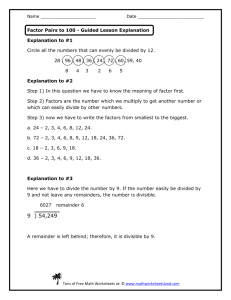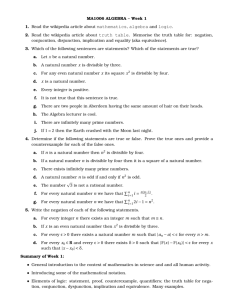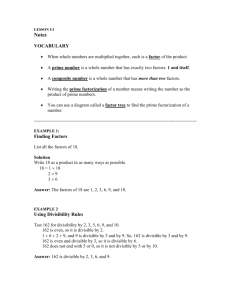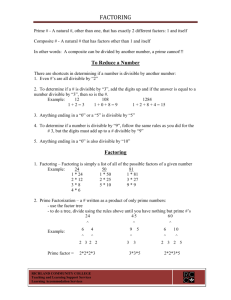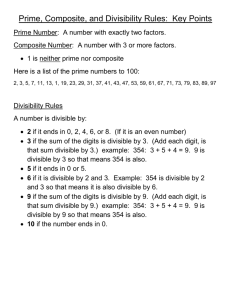Document
advertisement
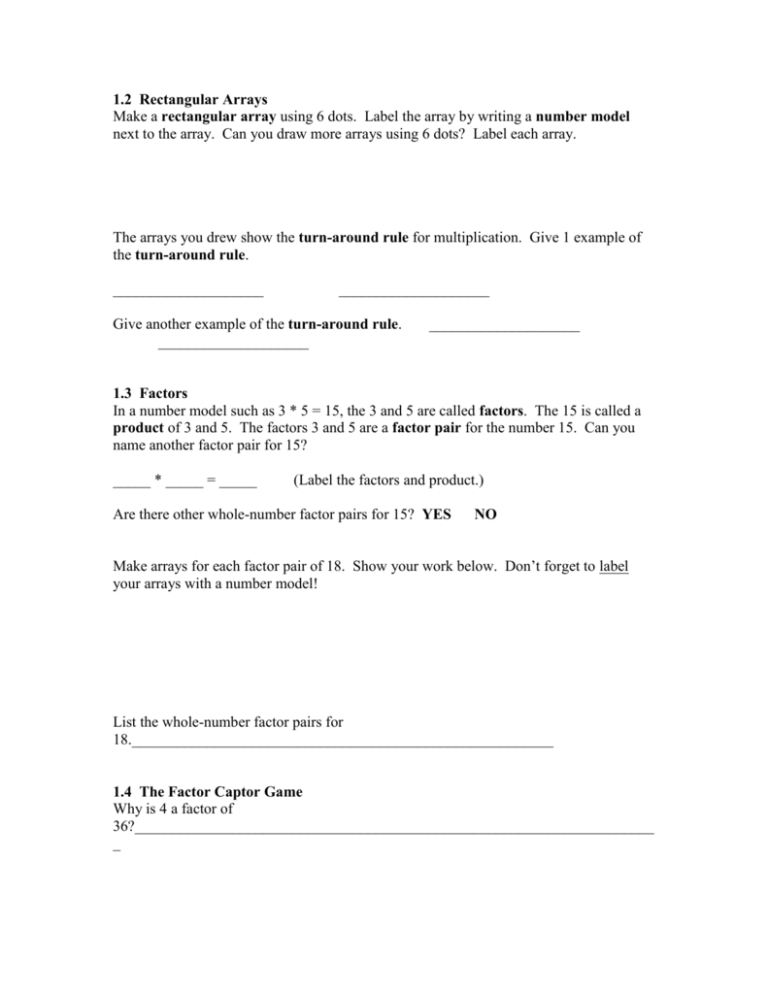
1.2 Rectangular Arrays Make a rectangular array using 6 dots. Label the array by writing a number model next to the array. Can you draw more arrays using 6 dots? Label each array. The arrays you drew show the turn-around rule for multiplication. Give 1 example of the turn-around rule. ____________________ ____________________ Give another example of the turn-around rule. ____________________ ____________________ 1.3 Factors In a number model such as 3 * 5 = 15, the 3 and 5 are called factors. The 15 is called a product of 3 and 5. The factors 3 and 5 are a factor pair for the number 15. Can you name another factor pair for 15? _____ * _____ = _____ (Label the factors and product.) Are there other whole-number factor pairs for 15? YES NO Make arrays for each factor pair of 18. Show your work below. Don’t forget to label your arrays with a number model! List the whole-number factor pairs for 18.________________________________________________________ 1.4 The Factor Captor Game Why is 4 a factor of 36?_____________________________________________________________________ _ Why is 5 not a factor of 36?___________________________________________________________________ When you are dividing 42 divided by 7, you can think: 7 times what number is 42? (6) Since you get a whole-number answer (6), you can say: 7 is a factor of 42 because 42 is divisible by 7. A number is divisible by another number if the result of the division is a whole number, with a remainder of zero. For example, 28 is divisible by 7 because 28 divided by 7 is 4, with a remainder of zero. Since 28 is divisible by 7, 7 is a factor of 28. Is 54 divisible by 9?_____ Why?_____________________________ Is 25 divisible by 6?_____ Why?_____________________________ Is 8 a factor of 48?______ Why?_____________________________ Is 4 a factor of 30?______ Why?_____________________________ 1.5 Divisibility A whole number is divisible by a whole number if the remainder in the division is zero. The answer to the division problem (quotient) must be a whole number. If the remainder is not zero, then the first number is not divisible by the second number. 30 is divisible by 5 because 30 / 5 = 6 Remainder 2 or 7.5 6 is a whole number, so a decimal in the 30 is divisible by 5 30 is not divisible by 4 because 30 / 4 = 7 Since there is a remainder in the answer (or answer), this means 30 is not divisible by 4. If checking for divisibility on a calculator, if you see a decimal in the answer to a division problem then first number is not divisible by the second number. (27 divided by 5 = 5.4 since the answer has a decimal, 27 is not divisible by 27. There are different tests you can do to determine if a number is divisible by another number: All numbers are divisible by _____. A number is divisible by 2 if it ends in a _____ _____ _____ _____ _____. A number is divisible by 3 if the sum of its digits is divisible by 3. Example: 246 is divisible by 3 because 2 + 4 + 6 = 12, and 12 is divisible by 3 12 / 3 = 4 A number is divisible by 6 if it is divisible by both 2 and 3. Example: 246 is divisible by 6 because it is divisible by both 2 and 3 (it ends in a 6, so it is divisible by 2 and 2 + 4 + 6 = 12, and 12 is divisible by 3 12 / 3 = 4) A number is divisible by 9 if the sum of its digits is divisible by 9. Example: 51,372 is divisible by 9 because 5 + 1 + 3 + 7 + 2 = 18, and 18 is divisible by 9 18 / 9 = 2 A number is divisible by 5 if it ends in a _____ or _____. A number is divisible by 10 if it ends in a _____. Try using the divisibility test for 3. See if these numbers are divisible by 3: Is 237 divisible by 3?_____ Why?_____________________________________________________________ Is 415 divisible by 3?_____ Why?_____________________________________________________________ Write a number that is divisible by 3: __________ Why?_____________________________________ 1.6 Prime and Composite Numbers __________ Numbers _______________ Numbers Definition:_______________________________ Definition:_________________________________ Write the factor pairs for each number and then make a factor rainbow number. 2-dot arrays 4-dot arrays 5-dot arrays 10-dot arrays 11-dot arrays 16-dot arrays 1.7 Square Numbers The number 16 can make an array that has the same number of rows and columns. (4 by 4 array) Draw the array below and make a square around it. Because the array is shaped like a square, it is called a _______________ _______________. Therefore, the number 16 is called a _______________ _______________. Draw the square array for the number 1 the number 4 Don’t forget to draw a square around it! around it! Draw the next square array. have?____ Draw the square array for Don’t forget to draw a square How many rows and columns does it What is the square number?____ Draw the next square array. have?____ How many rows and columns does it What is the square number?____ 1.8 Unsquaring Numbers When you ask yourself: What number, multiplied by itself, is equal to 81? (9) you are “unsquaring” a number. Use your calculators to answer this questions: What number, multiplied by itself, is equal to 289?__________ Do not use the “square root” key. Another name for “unsquaring” a number is called finding the _______________ __________ of the number. Since 8 * 8 = 64, the square root of 64 is 8. 1.9 Factor Strings and Prime Factorizations A _______________ _______________ is a name for a number written as a product of at least two factors that are greater than 1. In a factor string, the number 1 may not be used as a factor. Example: A factor string for the number 24 is 2 * 3 * 4. You could also write the factor string in a different order, such as 2 * 4 * 3 or 3 * 2 * 4 or 3 * 4 * 2 What are two other ways you could write the factor string for 24?_______________ _______________ The length of the factor string for each of these examples is 3. You could write other factor strings for the number 24 using different lengths. Fill in the grid below, recording all possible factor strings for the number 24. Number Factor String Length 24 24 24 24 24 24 Fill in the grid below, recording all possible factor strings for the number 30. Number Factor String Length 30 30 30 Fill in the grid below, recording all possible factor strings for the number 50. Number Factor String Length 50 50 50 Fill in the grid below, recording all possible factor strings for the number 54. Number Factor String Length 54 54 54 54 54 54 Fill in the grid below, recording all possible factor strings for the number 72. Number Factor String Length 72 72 72 72 72 72 72 72 72 72 72 72 72 72 72 Fill in the grid below, recording all possible factor strings for the number 36. Number Factor String Length 36 36 36 36 36 36 36 36 What kind of numbers make up the longest possible factor string for a number?__________ ______________ The longest factor string for a number is called the __________ _________________________ of a number. Example: The prime factorization of 24 is 2 * 2 * 2 * 3 The easiest way to find the prime factorization of a number is to do a factor tree. Example: 24 3 * 8 2 * 4 2 * 2 Circle the prime numbers. The numbers you circle will be the prime factorization of the number 24. Make a factor tree for the number 20. Write out the prime factorization for the number 20:__________ 20
